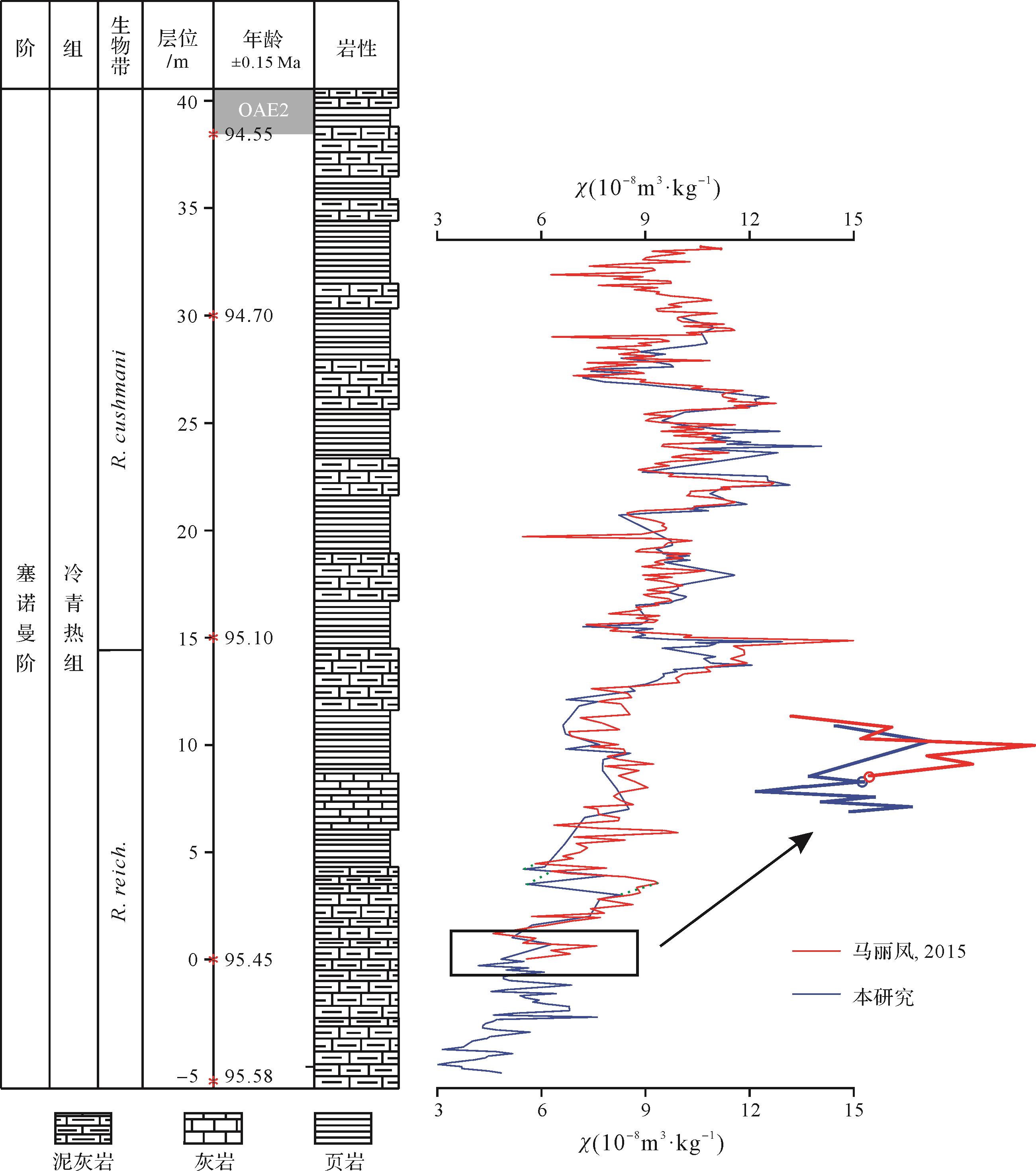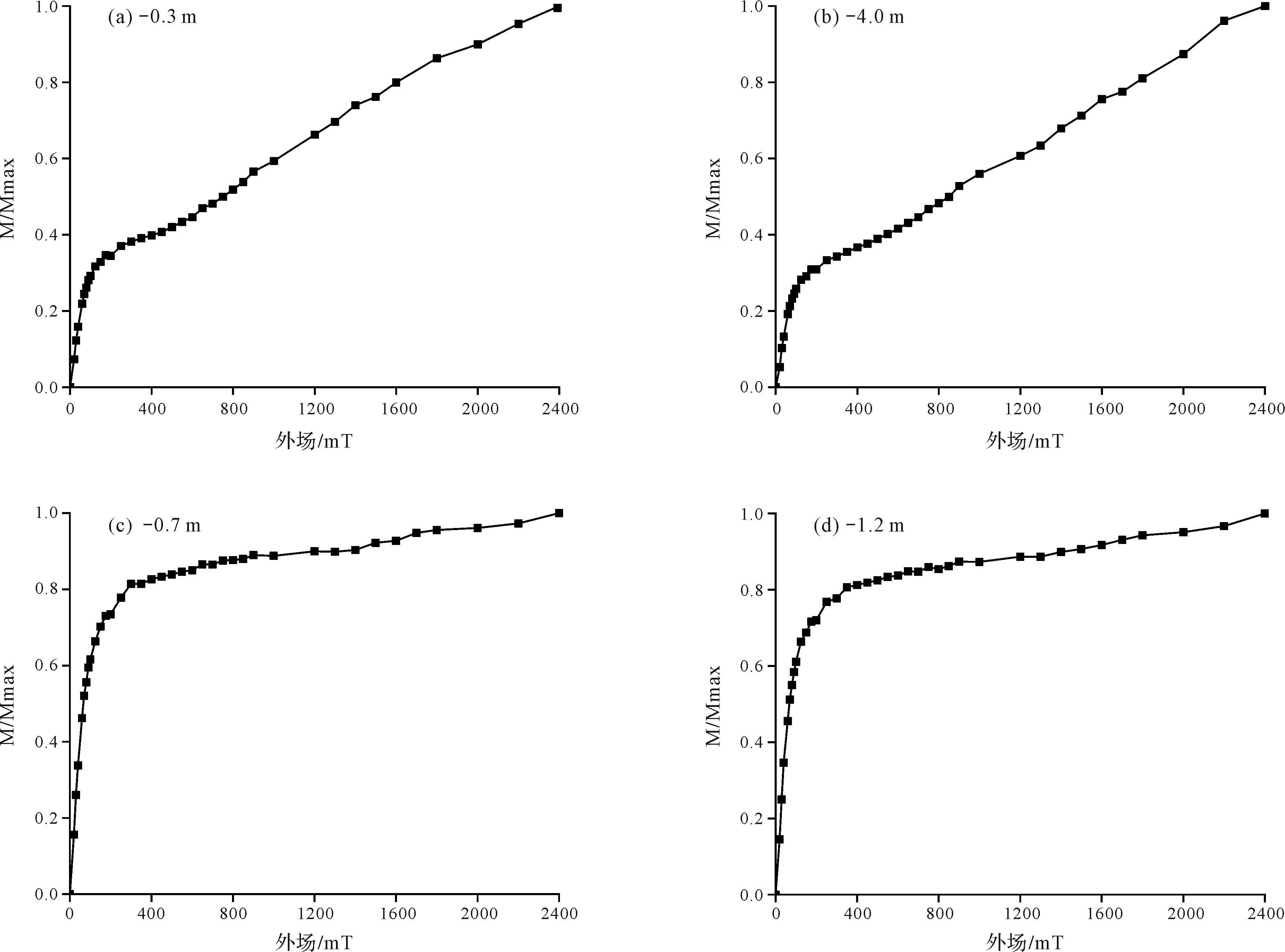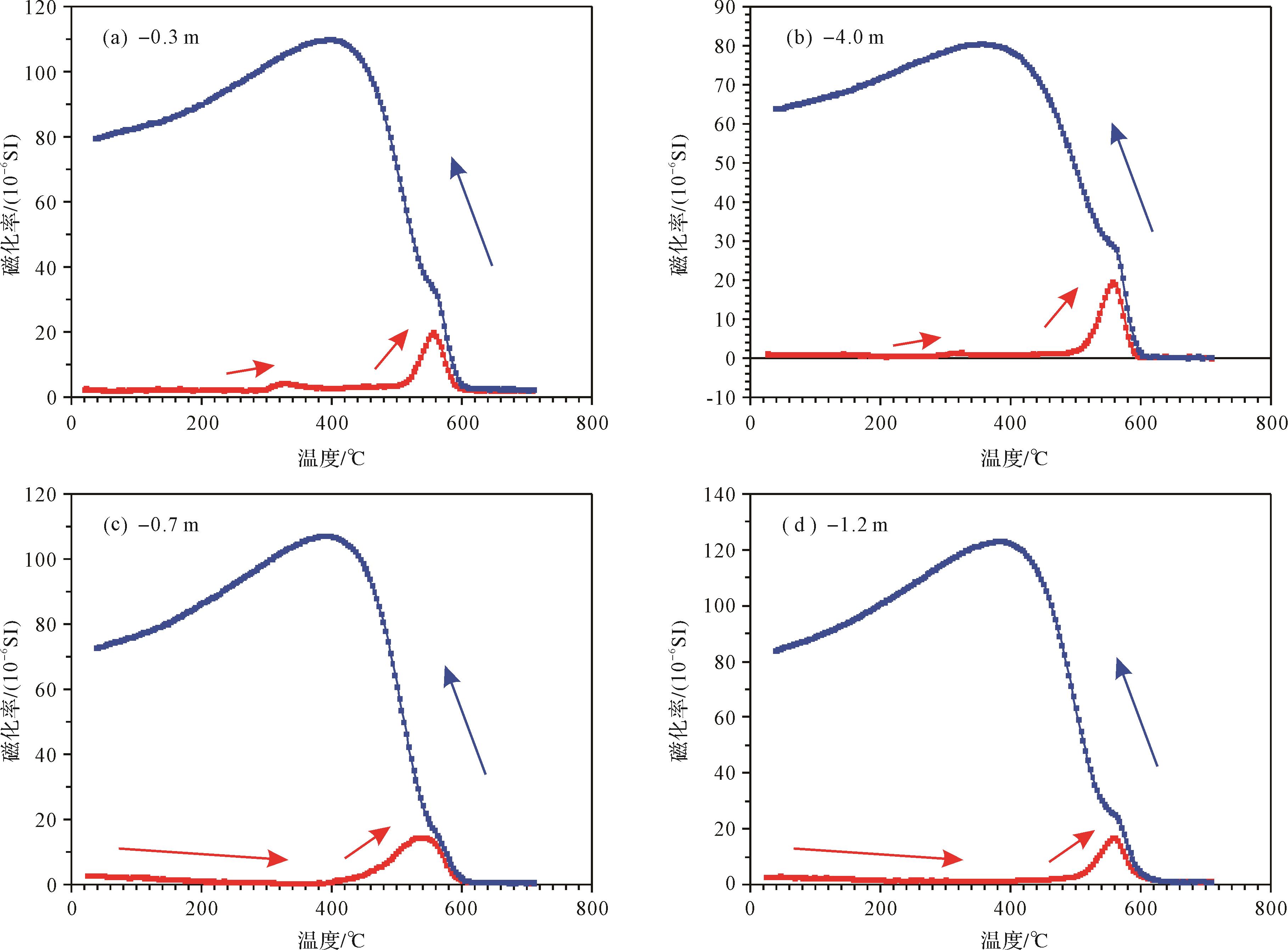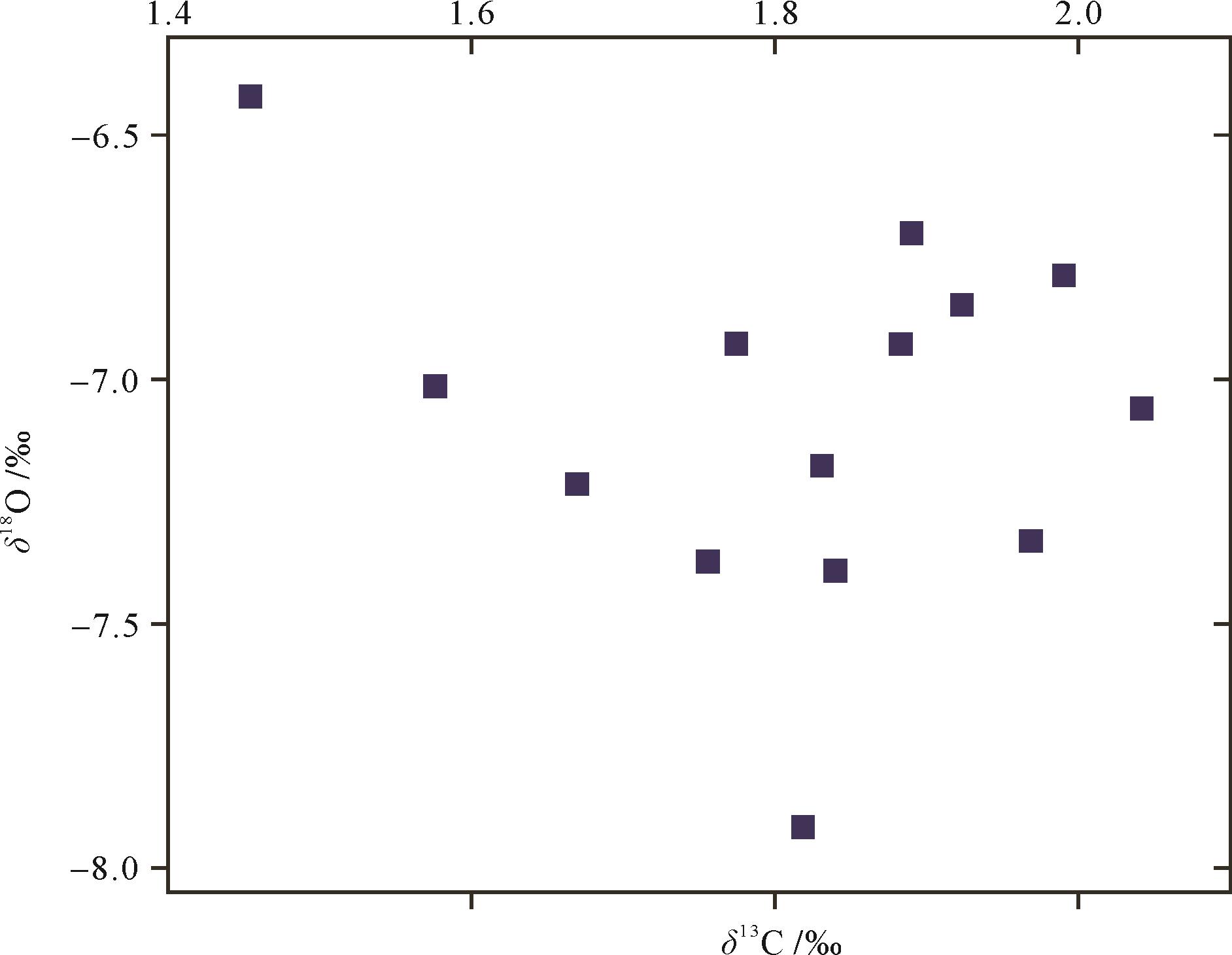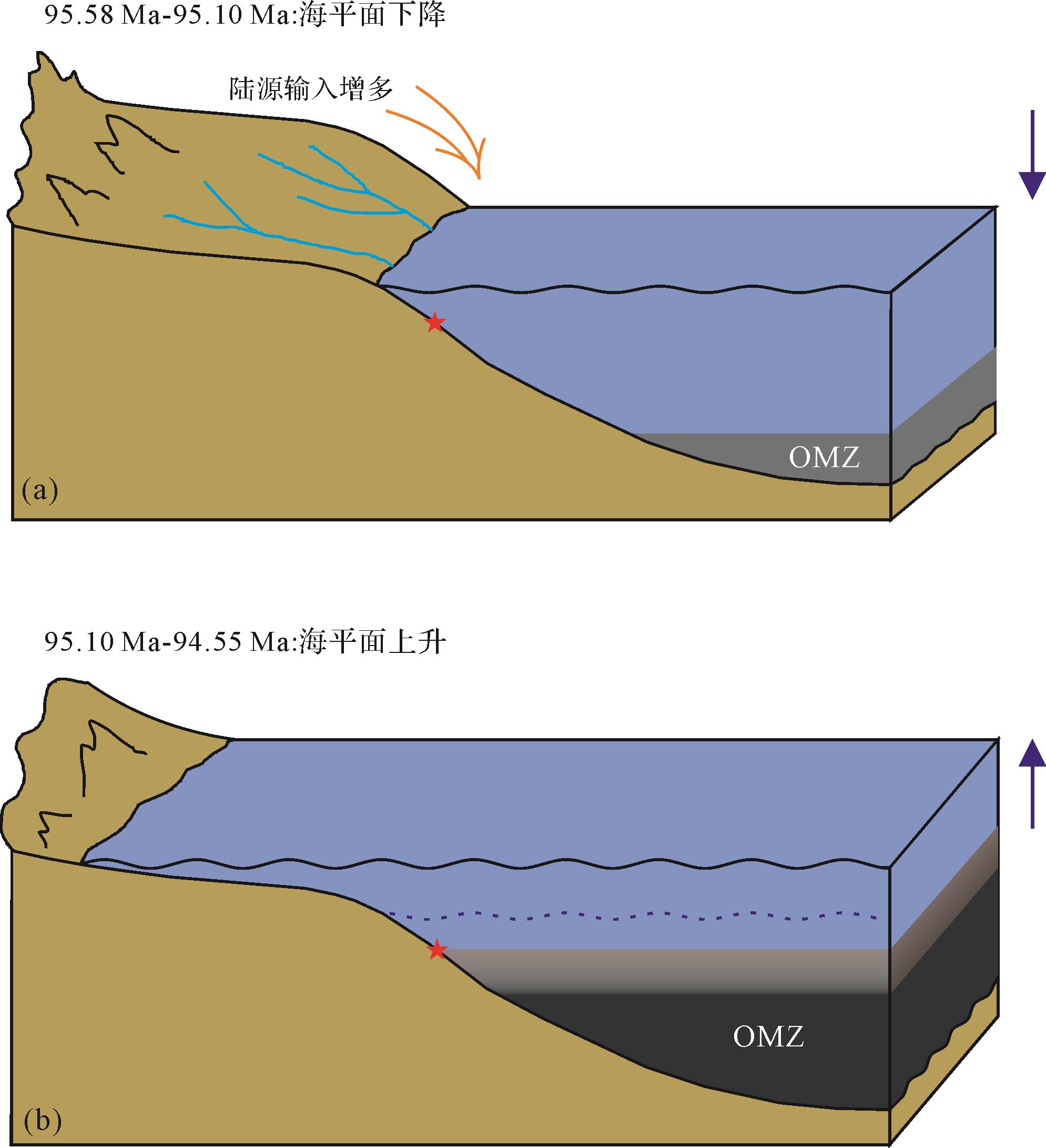HTML
-
白垩纪大洋缺氧事件(Oceanic Anoxic Events, OAEs)是发生于白垩纪中期(~120-90 Ma)温室地球时期的重大地质事件[1-2]。这些事件期间全球主要洋盆出现大范围缺氧[3-6],沉积了大量富有机质黑色页岩[4,7-8]。同时,也伴随着海洋生物的快速演替[9-10]以及对全球碳循环的重大扰动,表现为海、陆相记录中特征的、大幅度的碳酸盐和有机质的碳同位素漂移[2,11-15]。白垩纪中期的大洋缺氧事件主要包括白垩纪阿普特—阿尔布期(Aptian-Albian Stage)的OAE1a,OAE1b,OAE1c,OAE1d[16-18],塞诺曼—土伦期(Cenomanian-Turonian Stage)的OAE2[11,19-20]以及康尼亚克—圣通期(Coniacian-Santonian Stage)的OAE3[21-22]。自白垩纪大洋缺氧事件提出[1]以来,围绕这些事件的特征、时限、分布以及成因等方面已开展了大量研究工作[2,23-24],对于白垩纪大洋缺氧事件的认识也已取得了长足进展。就大洋缺氧事件的成因而言,通常认为,引起洋盆大范围缺氧及富有机质黑色页岩大量沉积的主要因素有两方面。一是温室地球状态使得海洋初级生产力提高,产生了大量的有机质,并导致洋盆缺氧[2,25];二是温室地球状态下,大洋环流减缓使得洋盆在缺氧环境下增强了保存有机质的能力[26-27]。而导致这两方面异常的根本原因被认为与白垩纪中期活跃的火山活动有关[28]。这是因为主要的大洋缺氧事件似乎与海洋中大火成岩省(Large Igneous Provinces, LIPs)的形成相伴[9,29]。海底大火成岩省形成过程中的火山活动向海洋和大气释放大量的CO2,使全球温室效应加剧,大洋环流减缓,导致洋盆缺氧,形成了有利于有机质大量埋藏的海洋环境。另一方面,加剧的全球温室效应也加速了全球水循环,并导致从大陆流入海洋的营养成分增加,从而使大洋初级生产力增强[3,30]。同时,活跃的火山活动及形成的大火成岩省的玄武岩与海水发生相互作用,向海水中注入了大量对海洋生物有重要生物化学意义的营养元素[23,31-35]。这也极大促使海洋初级生产力增强。大洋初级生产力的提高导致洋盆大范围的缺氧环境及富有机质黑色页岩的形成,并引起特征的δ 13C漂移[2,25]。
在白垩纪中期的多次大洋缺氧事件中,发生于塞诺曼/土伦(C/T)之交的大洋缺氧事件(OAE2)是研究程度最高的OAE事件之一[2,23],为探究白垩纪中期温室地球期间大洋缺氧事件形成与其他过程异常提供了一个重要窗口。OAE2发生于白垩纪中期温室地球的极热时期[36],应该是温室地球状态下发生的最具代表性的大洋缺氧事件。另外,在OAE2事件发生之前的白垩纪塞诺曼中期,还发生了另一个持续更短暂,碳同位素偏移幅度更小但与OAE2的碳同位素偏移趋势类似的古海洋事件,被称为中塞诺曼事件(mid-Cenomanian Event,MCE)[37-38]。中塞诺曼事件被认为是OAE2事件发生的前奏,为OAE2在塞诺曼/土伦之交的最终发生提供了必要的古海洋环境背景[27,39]。因此,探究从中塞诺曼事件到塞诺曼/土伦之交发生OAE2期间,即晚塞诺曼期的古海洋环境显然对于理解OAE2的成因机制至关重要。
部分地区开展的针对晚塞诺曼期古海洋学、海平面变化和古生物及环境演化的研究[10,39]表明OAE2和MCE的触发机制和气候—碳循环反馈具有一定的可比性,且两事件似乎均与海平面变化有一定关联。但对于海面变化与OAE2之间的联系、古海洋环境演化对OAE2的发生、海平面变化的年龄约束等诸多问题仍需进一步研究。
我国西藏南部是研究晚塞诺曼期古海洋环境变化的理想地区。藏南地区在古地理上处于特提斯洋东段,发育了广泛的白垩纪海相沉积,并记录了多次大洋缺氧事件[10,18-19,40]。前人通过对定日贡扎地区出露的白垩纪海相地层的岩石地层、生物地层以及碳同位素化学地层学研究限定了塞诺曼—土伦阶的界线和OAE2事件层位[19,41-44],探讨了OAE2期间的古环境变化[42,45-46] 。Li et al. [14]对定日贡扎剖面开展了高分辨率磁化率和碳同位素地层分析,并开展了旋回地层研究,获得了目前有轨道尺度年代约束的、分辨率最高、最完整的OAE2记录。而且,该高分辨率OAE2记录与全球主要的海、陆相OAE2记录可进行高分辨率对比[14]。因此,定日贡扎剖面已成为研究东特提斯域OAE2事件的一个典型剖面[14,19]。前人在贡扎剖面已经用不同的环境替代指标研究了古海洋环境变化[42,45-48]。但是,以往研究的重点是重建OAE2期间的古环境变化,对于从MCE到OAE2的晚塞诺曼期的古海洋环境变化的详细研究仍然缺乏。针对这一关键科学问题,本研究在前人在定日贡扎剖面研究基础上,主要运用岩石磁学指标,重点对藏南记录中OAE2事件发生之前的晚塞诺曼期的古海洋环境变化开展深入研究。岩石中磁性矿物含量、类型、粒度会受到沉积环境的影响而变化,相应地,通过刻画、分析沉积岩的岩石磁学参数的变化可以揭示古环境的变化[49-51]。
-
本文研究区位于我国藏南地区。该区由五个构造单元组成,由北向南分别是:冈底斯岩基、日喀则弧前盆地、雅鲁藏布江缝合带、特提斯喜马拉雅和高喜马拉雅。研究区属于特提斯喜马拉雅构造单元(图1a)。以定日—岗巴大断裂为界,可以将特提斯喜马拉雅分为以江孜地区为代表的北亚带和以岗巴定日地区为代表的南亚带。特提斯喜马拉雅在古地理上位于特提斯洋东段(图1b)。不同于以深海、半深海沉积物为主的北亚带,长期处于稳定的浅海陆棚沉积环境的南亚带主要由碳酸盐和外陆架陆源物质组成[53-55]。

Figure 1. Maps of the location of the studied Gongzha section at (a) ~90 Ma, and (b) present day(modified from references[19,52])
位于特提斯喜马拉雅南亚带的定日贡扎地区出露一套完整的上白垩统地层。该套地层从下往上包括察且拉组、冷清热组、岗巴村口组和宗山组。前人对该地区的上白垩统地层已经从生物地层[41,44]、旋回地层[14,56-57]、层序地层[57]以及化学地层[14,19,42,58]等多方面开展了研究。 其中,塞诺曼—土伦阶地层记录了白垩纪大洋缺氧事件OAE2[14,19,42-43,45,59]。对贡扎剖面包含塞诺曼—土伦阶界线的0~70 m的地层的高分辨率碳同位素分析显示OAE2层位出现于冷青热组的顶部和岗巴村口组底部。OAE2事件起始于该剖面的37.2 m处,事件层位共厚约35 m[14]。旋回地层学研究将OAE2事件的起始年龄限定为(94.55±0.15) Ma[14]。马丽凤[47]和Li et al. [48] 在该剖面运用岩石磁学指标重点探讨了OAE2期间的古海洋环境变化。而且这些研究及Li et al. [19]、Li et al. [14]等研究在剖面野外露头上标注了主要层位的高度。这些为本研究在该剖面深入探析晚塞诺曼期的古海洋环境变化提供了极大的便利和重要的约束。
-
围绕本研究的主要科学目标,即探究晚塞诺曼期的古海洋环境变化,我们主要对贡扎剖面OAE2事件起始层位37.2 m以下的地层勘查,并尝试将原剖面向下延伸,即也包含原剖面0 m以下的地层,以便尽可能获得完整的晚塞诺曼期的地层记录。该剖面出露于海拔约4 700 m的山脊上。剖面0 m 以下的山坡上覆盖较为严重。我们进行了大量的野外勘查,发现山脊附近冲沟中有较好的露头。因此,我们尝试将山脊上的露头与附近冲沟中的地层来对接,以期向0 m下延伸剖面。结果发现冲沟中的地层存在局部岩层产状变化,指示岩层可能发生了错动,很难将原山脊上的露头与附近冲沟中的地层建立准确的层与层的对接。鉴于此,我们对山脊上原剖面0 m以下的露头做了仔细野外分析,在山脊露头上,向0 m以下延伸了约6 m,即延伸到层位-6 m。-6 m以下没有连续的露头,无法将剖面再向-6 m以下延伸。因此,我们对新延伸的0 m至-6 m 的地层以10 cm间距采样,采样至-5.3 m处。另外,为了与马丽凤[47]和Li et al.[14,48]在该剖面已有的0 m以上岩石磁学数据对比、衔接,进而在该剖面上获得层位一致、连续的晚塞诺曼期的岩石磁学数据,本研究也对剖面0 m至30 m以10 cm间距采样。
在室内,首先将野外采集的无定向块状样品做前处理获得新鲜样品,然后再将其切成2 cm边长的立方体块样。对每个样品经称重后,进行下一步岩石磁学测量。另外,等间距挑选0 m以下14个层位的样品用于测量其碳同位素(δ 13Ccarb)。用牙钻垂直其新鲜表面钻取粉末。样品钻取时避开后期形成的方解石脉,以消除成岩作用对样品碳同位素结果的影响。
-
测量磁化率(χ)、非磁滞剩磁(ARM)以及等温剩磁(IRM)等岩石磁学参数。使用AGICO KLY-3卡帕桥磁化率仪测量样品的体积磁化率(κ),两次重复测量后,取平均值为体积磁化率值,经质量归一化后获得质量磁化率(χ)。测量了所有样品的磁化率。对0 m以下的样品还开展了ARM、IRM等其他磁学参数的测量。用Molspin交变退磁仪及pARM装置在峰值为100 mT交变场和外加0.05 mT直流场下获得ARM,并通过2G-755岩石超导磁力仪进行测量。非磁滞剩磁磁化率(χARM)由ARM经质量归一化以及直流场归一化后获得。另外,选取了22件样品测量其等温剩磁获得曲线,从20 mT逐步,经36步增加至2.4 T。使用 ASC IM-10-30 脉冲磁力仪获得IRM,并用旋转磁力仪JR-6A进行测量。对于其余样品,先将在1.2 T磁场下获得的IRM定义为饱和等温剩磁(SIRM),然后测量反向300 mT磁场下获得的IRM-300mT,并由此计算出样品的硬等温剩磁(HIRM)(HIRM=[IRM-300mT+SIRM]/2)及S率(S-ratio)(S-ratio= -IRM-300mT/SIRM)。以上所有岩石磁学参数的测量在南京大学古地磁实验室完成。
-
在南京大学内生金属矿床成矿机制研究国家重点实验室完成样品的碳同位素测试分析。所用仪器为Finnigan公司的Delta Plus XP连续流质谱仪。测试结果以δ 13C和δ 18O同位素比值VPDB标准化表示,精度高于0.2‰。
2.1 野外勘查、采样及样品前处理
2.2 岩石磁学测量
2.3 δ 13C测试
-
本研究获得了贡扎剖面-5.3 m 至30 m的磁化率结果(图2)。为了将0 m以下延伸的地层中的岩石磁学结果与已有的0 m 以上的岩石磁学结果准确衔接,我们选择用磁化率作为地层对比的依据。将本研究获得的-5.3 m至30 m高分辨率磁化率结果与已有的0 m 至35.0 m 的磁化率结果[14,47](图2)对比,发现除2.5~4 m之间出现微小的层位错位之外,其他层位的磁化率值和剖面磁化率的总体变化趋势吻合良好。该错位由于在0~5 m区间采样时,对区间内3 m、4 m层位划定略有测量误差导致。因为0 m及5 m地层处有前人标记,该错位并不影响剖面的对比衔接。鉴于前人已对0 m以上地层开展较为深入研究,0~5 m地层数据仍以前人为准。根据磁化率变化趋势和对比归一化后的质量磁化率值大小,将延伸地层的-0.1 m处与原剖面0 m处对应。相应的,将本研究获得的-0.10 m至-5.30 m层位的岩石磁学结果的层位统一向上移0.10 m与已有的原剖面0 m至40.0 m的岩石磁学结果[14,47]衔接。这样究形成基于磁化率的,从-5.20 m至37.2 m统一、完整的晚塞诺曼期的岩石磁学数据,用于分析研究剖面晚塞诺曼期古海洋环境的变化。
-
沉积物中磁性矿物的含量通常可由磁化率(χ)、非磁滞剩磁磁化率(χARM)和饱和等温剩磁(SIRM)指示。χ常用来反映物质被磁化的难易程度。沉积物中顺磁性、抗磁性和铁磁性颗粒均对χ有贡献,因而χ可以粗略反映磁性矿物的含量[49]。χARM对稳定单畴的亚铁磁性颗粒敏感。因此,可以指示较细的亚铁磁性矿物颗粒的相对含量[60];沉积物中所有亚铁磁性矿物的含量则用SIRM来估计[49]。如图3a~c所示,χ自剖面底部向上表现为先增大后又略微减小,但总体上呈增大的趋势。χARM则自剖面底部向上呈现逐步变大的趋势。同样,SIRM也显示出逐步增大的趋势。以上结果表明,从-5.2 m至0 m,地层中磁性矿物含量表现为逐渐增多的趋势。
-
沉积物或者岩石中高矫顽力“硬”磁性矿物的含量可由S-ratio和HIRM表征。S-ratio越小,对应的HIRM越大,指示高矫顽力磁性矿物(如赤铁矿、针铁矿)含量越多。相应的,低矫顽力磁性矿物相对含量增多时,S-ratio越趋近1,HIRM则越小[61-62]。图3g和h展示从-5.2 m至0 m地层的S-ratio和HIRM的变化。结果显示这些样品的S-ratio在0.2~0.9之间变化,表明这些样品中含有两种不同的矿物类型:一部分样品的S-ratio为0.7~0.8,即样品中存在低矫顽力磁性矿物;其余样品的S-ratio为0.2~0.4,即样品中存在高矫顽力磁性矿物。样品HIRM的变化与S-ratio的变化相互对应,即HIRM高值对应于S-ratio低值。因此,-5.2 m至0 m地层中不仅含有低矫顽力磁性矿物,也存在高矫顽力磁性矿物。
该地层-0.3 m和-4.0 m处样品的等温剩磁获得曲线显示在2.4 T外场下其等温剩磁强度仍然没有达到饱和,在300 mT时获得的等温剩磁强度仅为在2.4 T外场下获得的等温剩磁强度的34%~38%(图4a,b)。这说明该样品中高矫顽力磁性矿物为其饱和等温剩磁(SIRM)的主要载磁矿物。而-0.7 m和-1.2 m处的样品在300 mT时获得的等温剩磁强度是最大外场下获得的等温剩磁强度的78%~81%(图4c,d)。这表明这些样品中低矫顽力磁性矿物为其SIRM的主要载磁矿物。
样品的磁化率随温度变化曲线(κ-T曲线)也可用于判别磁性矿物类型。代表性样品的κ-T曲线显示样品的磁化率随温度变化特征基本一致(图5)。-0.3 m和-4.0 m处的样品显示其磁化率在室温加热至300 °C时保持稳定;300 °C到325 °C磁化率随温度升高,325 °C到400 °C磁化率随之下降,表明沉积物中有铁硫化物(磁黄铁矿[Fe7S8]或胶黄铁矿[Fe3S4])存在;400 °C到550 °C磁化率再次随温度升高,当温度提升至580 °C,即磁铁矿的居里点时,磁化率急剧下降,表明在加热的过程中有磁铁矿出现;温度升至640 °C时磁化率衰减至最小值,表明沉积物中有赤铁矿存在。而-0.7 m和-1.2 m处的样品显示其磁化率在室温加热至400 °C缓慢降低,表明样品中含有顺磁性矿物;400 °C之后的曲线变化与之前样品变化相似,表明沉积物中有赤铁矿与磁铁矿存在。所有样品冷却曲线均远高于加热曲线,说明有亚铁磁性矿物在加热过程中生成,从600 °C急剧增加,表现出磁铁矿的性质,可能是顺磁性矿物加热转化为磁铁矿。

Figure 5. Changes of magnetic susceptibility with sample temperature from the interval 0 m to -5.2 m, Gongzha section
综合等温剩磁获得曲线和κ-T曲线,0到-5.2 m地层的磁性矿物主要为磁铁矿、赤铁矿及铁硫化物(磁黄铁矿[Fe7S8]或胶黄铁矿[Fe3S4])。
-
磁性矿物颗粒大小通常由χARM/χ、χARM/SIRM和SIRM/χ指标反映。当磁性矿物颗粒粒径大于超顺次颗粒(SP)时,三个参数的数值越小,指示磁性矿物颗粒越粗;反之,这些参数的值越大时,反映磁性矿物颗粒越细[60,63]。研究地层的χARM/χ、χARM/SIRM和SIRM/χ随深度变化显示小幅度波动,但总体稳定(图3d~f),暗示研究岩层中磁性矿物粒度总体较一致,并无显著变化。
-
14个样品的碳同位素测试分析结果显示,δ 13C的最大值为2.04‰,最小值为1.45‰,相差0.59‰(图3i)。δ 13C和δ 18O不存在相关性(图6),表明δ 13C没有受到后期成岩作用的改造。综合来看,OAE2层位之下的地层中,由下至上δ 13C值并没有明显的变化趋势。
3.1 地层学结果
3.2 岩石磁学结果
3.2.1 磁性矿物含量
3.2.2 磁性矿物类型
3.2.3 磁性矿物粒度
3.3 碳同位素结果
-
因为本研究的重点是探析OAE2事件发生之前的古海洋环境变化,所以,本研究的目标层位从-5.20 m至OAE2事件的起始层位。贡扎剖面高分辨率OAE2记录显示,OAE2事件起始于剖面的37.2 m处,所对应的年龄为(94.55±0.15) Ma[14](图2)。前人在其他剖面的研究表明,中塞诺曼事件(MCE)发生于~96 Ma,表现为~1‰的特征碳同位素正漂[37-38]。本研究获得的-5.20 m至0 m的碳同位素结果并未显示出~1‰幅度的碳同位素漂移(图3i)。这说明,MCE层位应该位于-5.20 m以下,也就是说-5.20 m处的年龄应该小于96 Ma。鉴于-5.20 m至0 m地层岩性与0 m至5.0 m的地层岩性相似,我们采用贡扎剖面0~70 m的轨道尺度年代标尺[14],结合0 m至5.0 m的沉积速率(1 m/0.23 Ma)来估算-5.20 m至0 m段地层的年龄。由此获得研究剖面最底部-5.20 m处的年龄约为(95.58 ± 0.15) Ma。因此,本研究的目标层位是从-5.20 m至37.2 m,对应的晚塞诺曼期的年代范围为(95.58±0.15) Ma至(94.55±0.15) Ma(图2)。
-
沉积岩磁性特征的变化与沉积物物源、沉积环境以及沉积后的成岩作用有关[49,64-66]。陆源输入量会直接受到物源区与洋盆之间距离的改变而变化,进而引起沉积物中磁性矿物粒度和含量的变化[67]。沉积区海洋环境的改变也会对磁学性质产生显著影响[68-69]。因此,沉积物磁性参数的变化可以反映古海洋环境的演变。此外,后期成岩作用也会影响海洋沉积物的磁性特征。贡扎剖面岩石中有机质含量很低,总有机碳含量(TOC)小于1%[70],而且其碳酸盐的碳同位素变化趋势与全球其他地区同时代的记录均可对比[14,19,45]。这些特征表明该剖面的沉积记录几乎没有受到后期成岩作用的影响。故贡扎剖面的磁性特征主要受到物源输入和沉积环境的影响。
研究层位的岩石磁学参数显示磁化率(χ)、非磁滞剩磁磁化率(χARM)和饱和等温剩磁(SIRM)等参数从95.58 Ma至95.10 Ma期间表现出明显增大趋势(图7a~c),表明磁性矿物含量在此期间逐渐增多,且在(95.10±0.15) Ma时达到最大值。岩石中磁性矿物含量增多反映物源供给增加。研究剖面在塞诺曼期处于大印度北缘外陆棚沉积环境[42]。物源供给的增加或者是在海平面稳定情况下,物源区风化剥蚀增强引起;也有可能是海平面降低导致的物源区范围的增大而引起的。由于目前没有证据显示物源区在此期间风化剥蚀增强,沉积岩中磁性矿物的含量的增多更可能与海平面变化有关。这是因为,研究剖面处于外陆棚沉积环境,容易受全球海平面变化的影响[19,45]。而且,研究发现塞诺曼期(100.5~93.9 Ma[72])曾发生过多次全球性海平面变化事件,尤其是在塞诺曼晚期发生了一次幅度超过75 m的全球性海平面升降事件KCe4[71]。因此,研究剖面显示的从95.58 Ma至95.10 Ma期间的磁性矿物含量增多很可能是由于KCe4全球性海平面下降期间导致的物源区范围增大而引起的陆源输入量的增多(图8a)。如果是这样,那么磁性矿物含量增至最大值时应该对应于海平面下降至最低水平时,即晚塞诺曼期KCe4海平面在(95.10±0.15) Ma下降至最低。

Figure 8. Reconstructed Late Cenomanian (Mid⁃Cretaceous) paleoenvironmental change in the Tingri area (modified from reference[46])
95.10 Ma至94.55 Ma期间,磁化率(χ)、非磁滞剩磁磁化率(χARM)和饱和等温剩磁(SIRM)等参数总体稳定,仅显示小幅度波动(图7a~c)。这些小幅度波动可能指示沉积环境的细微变化。该研究剖面低分辨率氧化还原敏感微量元素(RSTE)数据[45]、生物化石记录[42]以及铁组分分析结果[48]表明定日地区在该阶段总体处于亚氧化(Suboxic)环境。岩石磁学参数的小幅波动可能暗示叠加于总体亚氧化环境上的从氧化(Oxic,溶解氧>1 mL/L)[73]、贫氧(Dysoxic,溶解氧含量处于0.1~1 mL/L)[73]、亚氧化(Suboxic,< 5 μmol/kg的低浓度溶解氧且存在反硝化作用)[74]至缺氧(Anoxic,溶解氧< 0.1 mL/L 或完全不存在溶解氧)[73]等不同氧化还原状态之间的细微变化。Li et al. [48]用Log(HIRM/χ)来指示贡扎剖面OAE2事件及附近层位的古海洋氧化还原环境的变化(图7d)。该指标在95.10~94.70 Ma保持相对稳定,在~94.70 Ma之后明显减小,并波动变化(图7d),说明研究区的沉积环境在~94.70 Ma发生了较大变化。磁性矿物的研究表明95.10~94.70 Ma期间沉积物的磁性矿物主要为磁铁矿、赤铁矿及铁硫化物(磁黄铁矿或胶黄铁矿),而在94.70~94.55 Ma期间,扫描电镜(SEM)及能谱分析(EDS)结果显示存在指示还原环境的草莓状黄铁矿(图7)[47-48]。这说明,研究区由95.10~94.70 Ma期间的亚氧化环境逐渐演变为~94.7 Ma之后更趋向于缺氧(Anoxic)的环境。
从95.10 Ma至94.55 Ma沉积环境逐渐趋向缺氧环境的变化趋势很可能也与KCe4海平面在~95.10 Ma达到最低之后的逐渐上升有关。海平面上升可以使得沿海植物和低地被淹没,海水中营养物质增加,导致海水生产力增加,从而引起海水中低氧带(oxygen minimum zone,OMZ)横向和垂向扩张[10,75]。研究区从95.10 Ma至94.55 Ma期间趋向更缺氧的沉积环境可能暗示KCe4海平面上升过程中OMZ扩张的影响逐渐波及到研究区的过程。这一认识得到剖面氮(N)同位素研究结果的支持。δ 15N在OAE2事件发生前表现为负漂,指示OMZ逐渐扩展至沉积区,导致沉积区的缺氧环境[46]。因此,(95.10± 0.15) Ma之后,随着海平面的上升及相伴的OMZ的逐渐扩张,很可能在(94.70±0.15) Ma海平面上升至较高水平,OMZ的边缘扩张至沉积区,引起了沉积区古海洋环境总体趋向缺氧环境的演化(图8b),并最终在94.55 Ma发生了OAE2事件。因此,(95.10± 0.15) Ma之后的大幅度海平面上升所引起的OMZ扩张可能是影响定日地区晚塞诺曼期古海洋环境演化及OAE2事件发生的重要因素。
-
在其他主要的OAE2剖面,包括美国普韦布洛、英国伊斯特本以及埃及西奈半岛显示碎屑指数在OAE2事件之前达到一个最大值,随后持续减小,也指示OAE2发生之前全球性海平面出现了先下降及随后持续上升的过程[45,76-78]。另外,在墨西哥东北部的瓦雷西洛(Vallecillo)[79]、意大利中部和北部地区[75]、摩洛哥Tarfaya盆地[80]和中国西藏的江孜地区[10]的研究均发现了在OAE2事件发生之前的晚塞诺曼期海平面上升引起的OMZ扩张现象。这些结果表明晚塞诺曼期OAE2事件发生之前的全球性海平面上升及相伴的OMZ扩张在东特提斯洋、西特提斯洋、原北大西洋(Proto-North Atlantic)及北美西部内陆海道(Western Interior Seaway)等很多海域产生了总体偏向缺氧的古海洋环境,为之后OAE2事件的广泛发生提供了必要的古海洋环境背景。由于定日贡扎剖面有高分辨率的年代标尺,本研究所获得的(95.10±0.15) Ma作为晚塞诺曼期海平面大幅上升的初始时间也可用于其他OAE2剖面深入分析塞诺曼晚期不同地区海平面上升,古海洋环境变化以及与OAE2发生的联系。
另外,晚塞诺曼期的海底火山活动被认为触发了OAE2事件[33]。海底火山活动可能是在OAE2事件之前~9 kyr(以OAE2持续时间为220 kyr计算)或~23 kyr(以OAE2持续时间为550 kyr计算)[33],或者~34 kyr(以OAE2持续时间为820 kyr计算[14])发生的。也就是说,在海平面上升阶段的晚期也发生了强烈的海底火山活动。白垩纪中期活跃的火山活动被认为是产生OAE事件的重要诱发因素[2,23,29-30,81]。因此,晚塞诺曼期的全球海平面大幅度上升和活跃的火山活动共同作用导致了OAE2事件的发生。
4.1 研究层位的年代
4.2 晚塞诺曼期定日地区古海洋环境变化
4.3 晚塞诺曼期全球海平面上升与火山活动
-
本文通过对藏南定日地区贡扎剖面上白垩统冷青热组地层(-5.2~37.2 m)的岩石磁学研究,重建了研究区晚塞诺曼期(95.58±0.15) Ma至(94.55±0.15) Ma期间的古海洋环境演化。岩石磁学结果显示:1)磁化率(χ)、非磁滞剩磁磁化率(χARM)和饱和等温剩磁(SIRM)等从95.58 Ma至95.10 Ma期间表现出明显增大趋势,且在(95.10±0.15) Ma时达到最大值,表明磁性矿物含量在此期间逐渐增多。该趋势很可能是由于KCe4时期全球海平面下降导致物源区范围增大而引起,且(95.10±0.15) Ma时海平面下降至最低水平。2)95.10~94.70 Ma期间沉积物中磁性矿物主要为磁铁矿、赤铁矿及铁硫化物(磁黄铁矿或胶黄铁矿),而在~94.70 Ma氧化还原环境发生较显著变化,出现了草莓状黄铁矿,表明研究区海洋环境从95.10~94.70 Ma间的亚氧化环境逐渐演变为~94.70 Ma后趋于缺氧的环境。这一氧化还原环境变化趋势很可能是由于~95.10 Ma之后的全球海平面上升引起的OMZ的扩张所导致的。由于本研究剖面具有精细的年代标尺,本研究限定的晚塞诺曼期KCe4海平面上升的初始时间,即(95.10±0.15) Ma,可以为研究其他剖面同期全球海平面上升对OAE2事件的发生提供重要的年代约束。结合晚塞诺曼期活跃的火山活动,我们认为晚塞诺曼期全球性海平面上升及火山活动共同作用导致了塞诺曼—土伦之交的全球性OAE2事件。












 DownLoad:
DownLoad:
